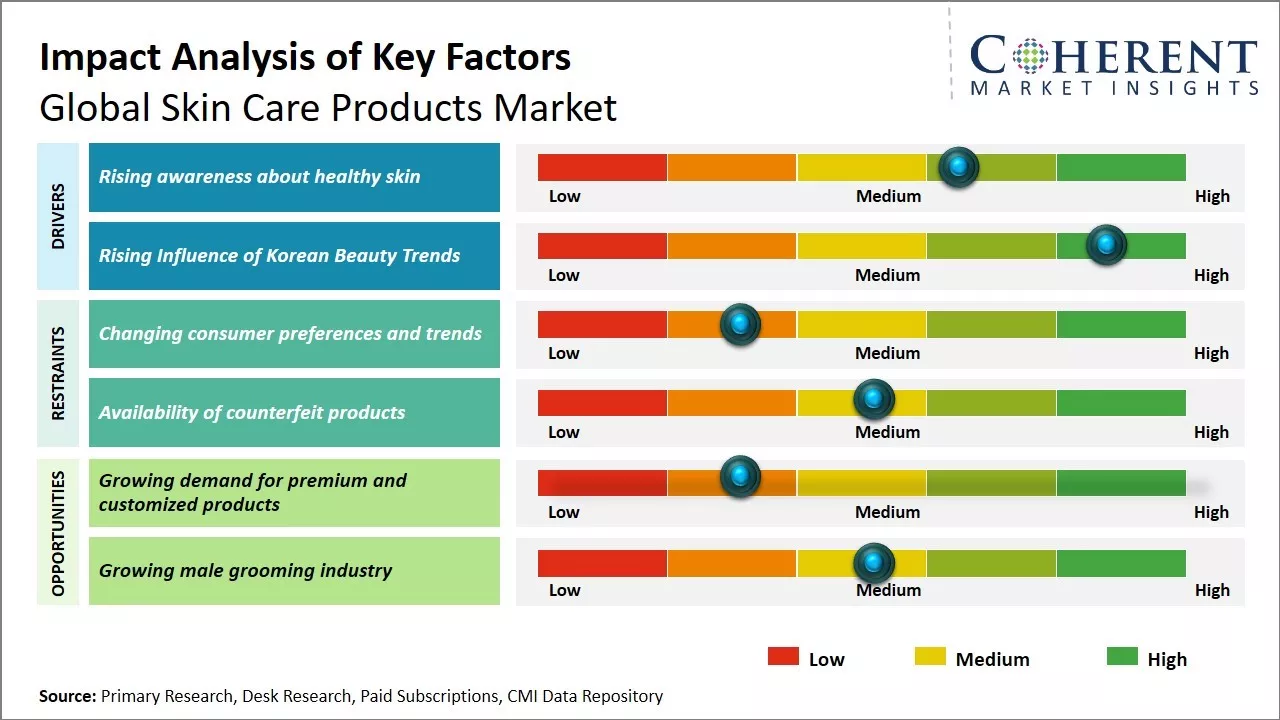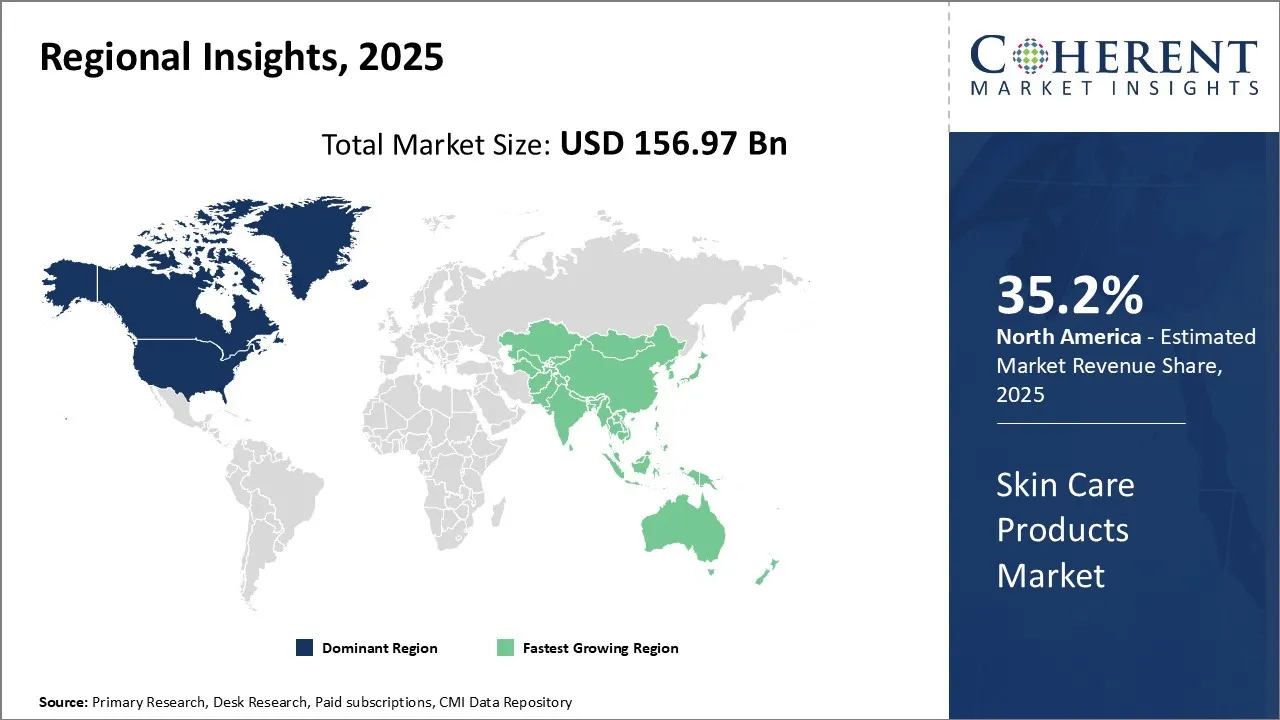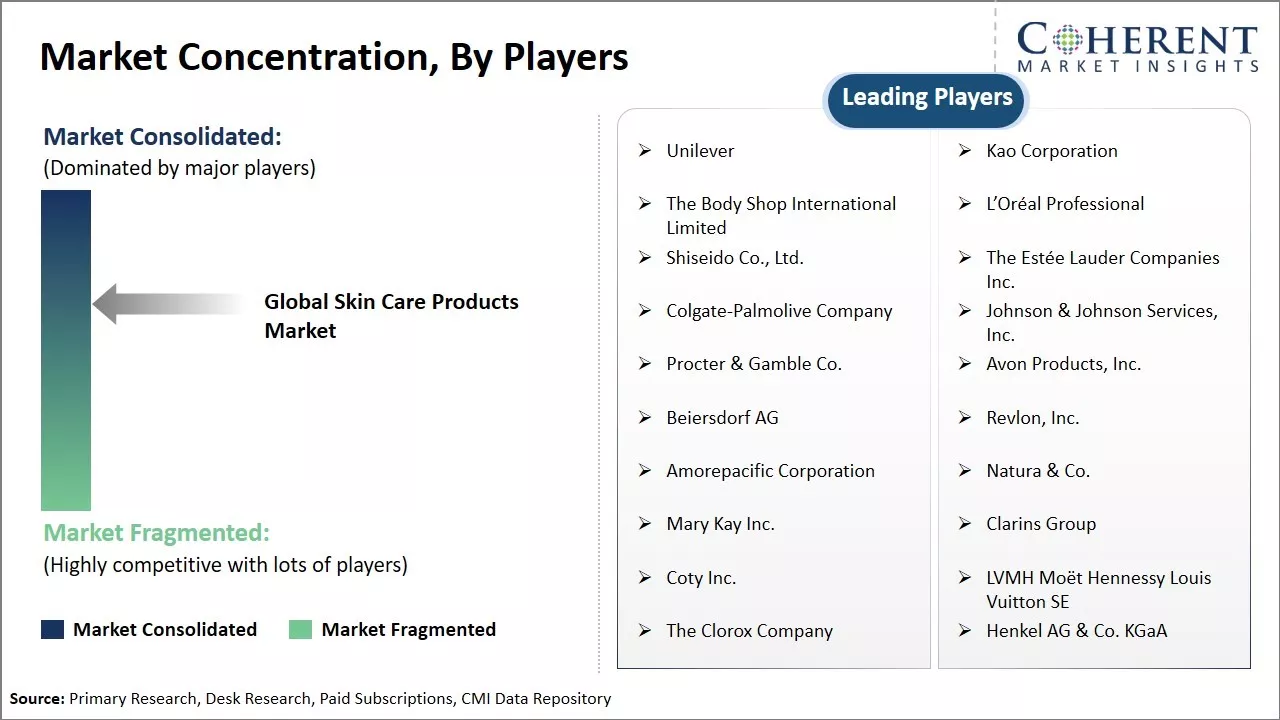The global skin care products market is estimated to be valued at USD 156.97 Bn in 2025 and is expected to reach USD 221.02 Bn by 2032, growing at a compound annual growth rate (CAGR) of 5.0% from 2025 to 2032.

To learn more about this report, Download Free Sample
Over the past few years, sales of natural and organic skin care products have gone up a lot in the skin care products market. More and more people want products that are made with natural ingredients and don't have any harmful chemicals in them. Big companies in the market have released new lines of natural products aimed at health-conscious customers who would rather use natural products. Some of the main things that are driving the demand for natural skin care products are improvements in natural and organic personal care formulations and successful marketing campaigns by brands. More people are learning about the benefits of skin care products that contain ingredients like coconut oil, aloe vera, and plant extracts. This is also helping this part of the skin care market grow.
|
Current Event |
Description and its Impact |
|
Climate Change and Environmental Health Crisis |
|
|
AI Technology Revolution in Personalized Skincare |
|
Uncover macros and micros vetted on 75+ parameters: Get instant access to report
Artificial intelligence is revolutionizing the skincare products market by driving hyperpersonalization and diagnostic precision. AI-powered tools can analyze skin conditions in real time, offering tailored product recommendations based on individual needs. Technologies like red light therapy and smart diagnostic devices are bringing clinical-grade treatments into homes. Generative AI is also reshaping product development, marketing, and customer service, with estimates suggesting it could add $9–10 billion to the global beauty economy. Virtual try-ons and augmented reality features further enhance customer engagement, allowing users to visualize results before purchase. As consumers increasingly expect adaptive, data-driven skincare solutions, brands embracing AI are gaining a competitive edge.
For instance, in April 2025, Nouryon unveiled BeautyCreations™, an AI-driven formulation discovery tool for personal care, at in-cosmetics Global in Amsterdam. Powered by Albert Invent, it enables formulators to search Nouryon’s extensive hair and skincare portfolio using natural language, streamlining product development and enhancing supplier-formulator collaboration.
In terms of the product type, the face creams and moisturizers segment is expected to hold 42.1% share of the market as people are learning more about how to keep their skin young. More people are putting skin care first these days due to the rising desire to live longer and making more money. People from all over the world agree that a young, well-hydrated face is beautiful. Face creams claim that they add essential nutrients and antioxidants to the skin to make it healthier from the inside out. Aso, they protect against harsh environment and slow down the appearance of aging signs such as dark spots and wrinkles. The idea of inner beauty and self-care has become more popular owing to the growing wellness industry. People now understand skin condition reflects their lifestyle habits. They wish to prevent accelerated aging caused by modern-day pressures. Given this, premium niche brands that sell organic ingredients that have been scientifically tested are becoming popular. People think that natural actives such as hyaluronic acid, retinol, vitamins C and E, and others are safer and work better.
For instance, in September 2025, Galderma launched Cetaphil’s new Skin Activator Hydrating & Firming Line, co-developed with dermatologists and featuring actress Mariska Hargitay. The line targets aging and fragile skin using microdosed AHA and encapsulated CICA to boost cell renewal and hydration. It’s now available across the U.S.
In terms of distribution channel, the online segment dominates the skin care products market with the highest share in 2025, due to their unmatched convenience, broad product selection, and personalized shopping experiences. Consumers enjoy 24/7 access, easy comparisons, and tailored recommendations powered by AI and virtual consultations. Social media platforms like Instagram and TikTok amplify product discovery through influencer endorsements and user-generated content, building trust and engagement. Subscription models offering curated skincare regimens are especially popular among younger demographics. With digital tools enabling skin analysis and customization, online platforms have become the preferred destination for skincare purchases, reshaping consumer behavior and driving significant growth across global markets.
For instance, in December 2024, L’Oréal Groupe acquired Dr.G, a leading Korean derma skincare brand under Gowoonsesang. Known for science-backed formulations and strong digital engagement, Dr.G enhances L’Oréal’s active cosmetics portfolio and strengthens its online presence, especially among Gen Z and millennial consumers in Asia’s fast-growing beauty market.
In terms of end user, the females segment contributes 38.9% share of the market in 2025 owing to skincare being strongly linked with self-expression and femininity culturally. Women have long invested more in appearances and treat beauty routines as nurturing rituals. In many households too, they control budgets for toiletry items and gifts. More people are accepting of individuality and non-conformity, which is leading to bolder ideas of what it means to be a woman today. Beauty is redefined on individual terms, less influenced by societal norms. Young girls, in particular, are always experimenting to try out different colors, styles, and textures.
For instance, in July 2025, Cosmo Pharmaceuticals introduced Winlevi®, a breakthrough acne treatment, in Singapore and Malaysia. Targeting both male and female patients, especially teens and young adults, Winlevi is the first topical androgen receptor inhibitor approved in these markets. The launch expands Cosmo’s dermatology footprint across Southeast Asia.

To learn more about this report, Download Free Sample
North America is most leading region in the world for skin care products market. North America has a 35.2% share of the market as it is hub of leading skincare brands like the U.S. and Canada. North America is a major player in the market for a number of important reasons. North American companies have an edge over their competitors when it comes to manufacturing and supply chain efficiency since they are home to major industry players. Established brands from the region have penetrated international markets through aggressive global expansion over the past decade. This has helped them reach more customers around the world. Additionally, North American consumers have been more interested in high-end and professional skin care products in the recent years.
For instance, in December 2024, Albéa Cosmetics & Fragrances launched its North America Collection, spotlighting innovative packaging inspired by local trends. The collection features sustainable, high-impact designs tailored for makeup and fragrance brands, blending eco-conscious materials with bold aesthetics. It reflects Albéa’s commitment to creativity, regional relevance, and responsible beauty solutions.
The Asia Pacific region has emerged as the fastest growing market for skin care products globally. Countries like China, India, and South Korea showcase immense potential for future market growth. Asia Pacific remains an attractive market fueled by expanding middle-class populations and urbanization. Rising living standards in Asia Pacific have translated to greater consumer focus on personal grooming and beauty regimes. Traditional herbal skin care ingredients form an integral part of the local beauty culture in many Asian countries. This has encouraged indigenous brands to leverage natural and indigenous ingredients in their product formulations.
For instance, in September 2025, Galderma introduced ALASTIN Skincare in China, expanding its premium dermatological portfolio in Asia. Known for its clinically proven anti-aging and post-procedure products, ALASTIN targets growing demand among Chinese consumers for science-backed skincare. The launch marks a strategic move to strengthen Galderma’s presence in the region’s booming beauty market.
The U.S. skin care products market is thriving due to rising consumer awareness, demand for clean and personalized products, and tech-driven innovations like AI diagnostics and smart devices. Influencer culture and wellness trends also fuel growth, making skincare a daily ritual for millions seeking effective, science-backed solutions.
For instance, in May 2025, e.l.f. Beauty signed a $1 billion agreement to acquire rhode, Hailey Bieber’s fast-growing skincare brand. The deal includes $800 million in cash and stock, plus a $200 million earnout. Bieber will remain Founder and take on expanded roles, aiming to drive global growth and innovation.
Japan’s skin care products market is booming due to its deep-rooted beauty culture, aging population, and demand for high-quality, science-backed products. Consumers prioritize gentle, effective formulations with advanced ingredients. Innovation, minimalism, and trust in local brands drive growth, while digital platforms and beauty tech enhance personalized skincare experiences.
For instance, in July 2025, Kao’s prestige brand KANEBO introduced its new Cream Duo globally on September 5, 2025. Inspired by “nature’s first skincare”, the protective vernix of newborns, the duo blends advanced hydration with skin barrier support. This signature release marks a milestone in KANEBO’s global expansion and commitment to nature-driven innovation.
| Report Coverage | Details | ||
|---|---|---|---|
| Base Year: | 2024 | Market Size in 2025: | USD 156.97 Bn |
| Historical Data for: | 2020 To 2024 | Forecast Period: | 2025 To 2032 |
| Forecast Period 2025 to 2032 CAGR: | 5.0% | 2032 Value Projection: | USD 221.02 Bn |
| Geographies covered: |
|
||
| Segments covered: |
|
||
| Companies covered: |
Unilever, Kao Corporation, The Body Shop International Limited, L’Oréal Professional, Shiseido Co., Ltd., The Estée Lauder Companies Inc., Colgate-Palmolive Company, Johnson & Johnson Services, Inc., Procter & Gamble Co., Avon Products, Inc., Beiersdorf AG, Revlon, Inc., Amorepacific Corporation, Natura & Co., Mary Kay Inc., Clarins Group, Coty Inc., LVMH Moët Hennessy Louis Vuitton SE, The Clorox Company, and Henkel AG & Co. KGaA |
||
| Growth Drivers: |
|
||
| Restraints & Challenges: |
|
||
Uncover macros and micros vetted on 75+ parameters: Get instant access to report
People all over the world are becoming much more aware of skin care as the focus on keeping skin healthy and looking younger for longer grows. People are more aware now that taking care of and maintaining their skin can help it look young and healthy. People have started to pay more attention to things like moisturizing, sun protection, exfoliating, quitting smoking, and other things that can hurt the skin over time. The fact that social media and online influencers are everywhere has made people even more aware of this. Many skin and beauty bloggers teach their millions of followers about the ingredients they should look for or stay away from in products. People have been taking better care of their largest organ thanks to celebrity endorsements and Instagram posts showing off daily routines. Growing disposable incomes have also allowed people to invest more in high-quality skin care products that cater to specific concerns and needs.
With more media focus on topics like anti-aging, reducing pigmentation, and treating acne, consumers are no longer satisfied with general skin creams. They want customized solutions to meet their requirements. This has led to lucrative growth opportunities for brands that offer tailored, results-oriented products developed by dermatologists or cosmetic chemists. Transparency regarding formulation has also become important with people carefully studying ingredient lists. The market is hence bifurcating into mass-market as well as premium, clinical grade segments. As people understand the signs of premature aging like fine lines, dullness etc. at an earlier age, prevention and maintenance are driving greater usage of serums, moisturizers SPF protection throughout their 20s and 30s not just 40s and 50s. More people are getting cosmetic procedures, which is good for the skin care industry because it means people want to look their best and feel good about themselves. In general, people of all ages and from all over the world are now pickier about these kinds of products because they know more about them.
The South Korean beauty industry has become a major player thanks to its new products, textures, and practices like double cleansing, which is now widely accepted. The trend, which is often called "K-Beauty," started to become popular in the late 2000s and has since spread around the world. International customers liked that the industry focused on natural, versatile, multi-tasking products that could be used every day.
Even though there are some problems, the global skin care products market has a lot of room to grow. People still want more high-quality and personalized goods. The market for products that help with wrinkles, dark spots, and other signs of aging is growing quickly as the world's population gets older and people focus more on anti-aging. Digital platforms and social media also let brands reach different types of customers and tailor their products to their needs.

To learn more about this report, Download Free Sample
The skin care products market value is evolving rapidly, driven by shifting consumer priorities and technological innovation. Today’s buyers are more informed, seeking transparency, clean ingredients, and personalized solutions. Social media and influencer culture amplify trends instantly, while AI-powered diagnostics and virtual try-ons reshape the shopping experience. Brands that blend science, sustainability, and storytelling are leading the charge.
Demand is no longer confined to traditional demographics: men, teens, and older adults are embracing skincare as part of wellness. Regional preferences also matter: while Asia favors multi-step routines and gentle actives, Western markets lean into minimalism and clinical efficacy. The future belongs to brands that listen, adapt, and innovate without losing authenticity.
*Definition: The global skin care products market consists of a wide range of skincare items that are developed and formulated to improve and protect skin health and appearance. These products include face creams, body lotions, cleansers, toners, scrubs, masks, and serums that are sold through various distribution channels worldwide. The market caters to the needs of consumers across different age groups and genders.
Share
Share
About Author
Sakshi Suryawanshi is a Research Consultant with 6 years of extensive experience in market research and consulting. She is proficient in market estimation, competitive analysis, and patent analysis. Sakshi excels in identifying market trends and evaluating competitive landscapes to provide actionable insights that drive strategic decision-making. Her expertise helps businesses navigate complex market dynamics and achieve their objectives effectively.
Missing comfort of reading report in your local language? Find your preferred language :
Transform your Strategy with Exclusive Trending Reports :
Frequently Asked Questions
Joining thousands of companies around the world committed to making the Excellent Business Solutions.
View All Our Clients